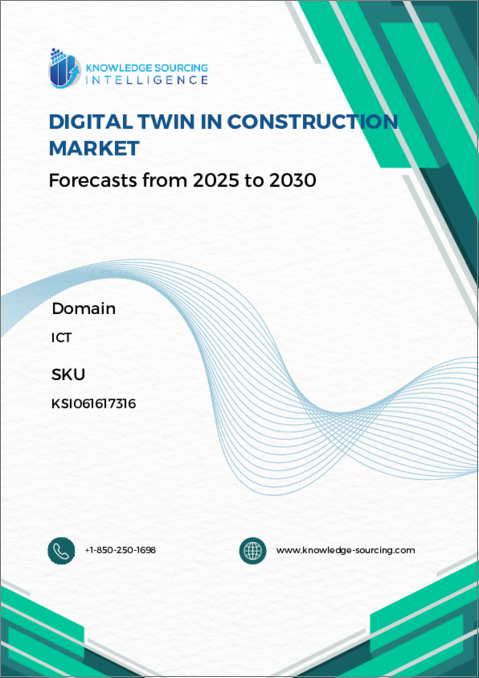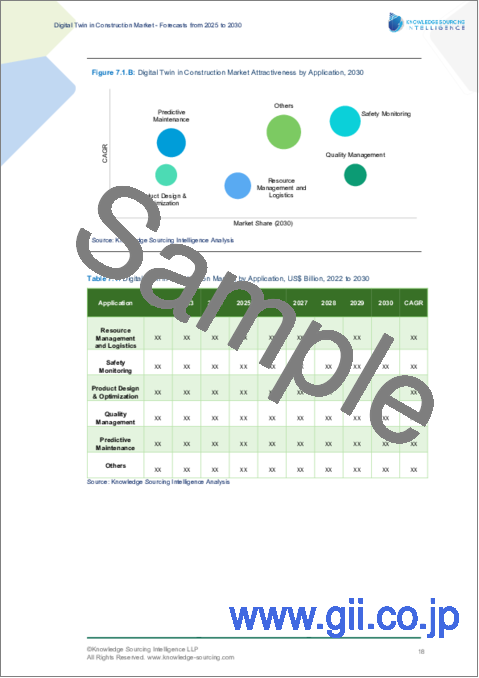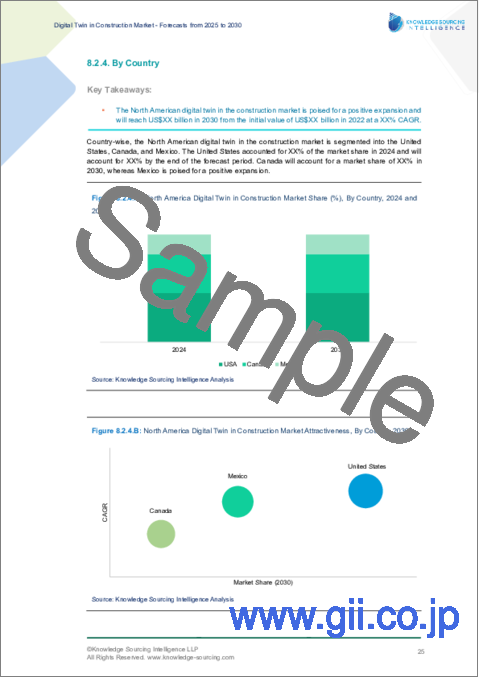|
|
市場調査レポート
商品コード
1697412
建設業向けデジタルツイン市場:将来予測 (2025年~2030年)Digital Twin in Construction Market - Forecasts from 2025 to 2030 |
||||||
カスタマイズ可能
|
|||||||
| 建設業向けデジタルツイン市場:将来予測 (2025年~2030年) |
|
出版日: 2025年02月10日
発行: Knowledge Sourcing Intelligence
ページ情報: 英文 146 Pages
納期: 即日から翌営業日
|
全表示
- 概要
- 目次
建設業向けデジタルツイン市場は、予測期間中にCAGR 17.03%で力強い成長を遂げ、2025年の648億6,500万米ドルから2030年には1,550億1,000万米ドルに達すると予測されています。
建設業向けデジタルツインは、3Dレーザースキャナー、ドローン、センサー、カメラ、その他のIoTデバイスなどの技術を活用し、実世界のデータを集約・合成して作成されます。IoTとAIによって実現されるデジタルツインは、異なるソースから自律的に学習し、物理的属性(形状、位置、ジェスチャー、動き)、相互作用、修正を反映して、実世界の対応するものをミラーリングするように動的に更新することができます。このデータには、オブジェクトの特性や状態に関する情報が含まれます。デジタルツインを建築物情報モデリング(BIM)プロセスに統合することで、請負業者や建築/エンジニアリング会社は、パフォーマンスの低下、収益性の低さ、エラーや事故率の上昇など、業界の重大な課題に対処することができます。さらに、デジタルツインは、入札の精度を高めながら、仮想設計と建設コストの削減を促進します。プロジェクトチームは、物理的な建設物や構造物、作業現場に変更を加える前に、予想される結果をデジタル上でテスト・分析できます。
建設業向けデジタルツイン市場の成長は、いくつかの主要な要因によって後押しされています。主な促進要因は、クラウドベースのプラットフォームの採用が増加していることです。クラウドベースのプラットフォームは、リアルタイムのデータ収集と分析のための強固な基盤を提供し、物理資産のますます複雑化するデジタルモデルの確立に不可欠です。クラウドプラットフォームのスケーラビリティとアクセシビリティはデジタルツインソリューションの実装を合理化し、主要なクラウドプロバイダーは包括的なデジタルツイン機能を導入しています。例えば、マイクロソフトはビル管理・建設向けにデジタルツインオントロジーを提供しています。また、財政的支援や規制の枠組みを通じて、建設における先進技術の採用を奨励する政府の取り組みが世界的に増加していることも、大きなきっかけとなっています。
建設業向けデジタルツイン市場は、地域によってさまざまな成長パターンを示しています。北米市場は、先端技術の統合、熟練労働力、支援的な規制環境によって拡大しています。欧州では、ビッグデータ分析、IoT、人工知能(AI)、機械学習(ML)などの技術の出現とインダストリー4.0技術によって成長が促進されています。アジア太平洋市場は、技術の進歩、生産量の増加、デジタルネットワークの拡大が成長の原動力となっています。最後に、南米、中東・アフリカ地域は、技術進歩を促進する政府のイニシアチブの増加に支えられ、大幅な成長が見込まれています。
当レポートを購入する理由
- 洞察に満ちた分析:顧客セグメント、政府政策と社会経済要因、消費者の嗜好、産業別、その他のサブセグメントに焦点を当て、主要地域だけでなく新興地域もカバーする詳細な市場考察を得ることができます。
- 競合情勢:世界の主要企業が採用している戦略的作戦を理解し、適切な戦略による市場浸透の可能性を理解することができます。
- 市場促進要因と将来動向:ダイナミックな要因と極めて重要な市場動向、そしてそれらが今後の市場展開をどのように形成していくかを探ります。
- 行動可能な提言:ダイナミックな環境の中で、新たなビジネスストリームと収益を発掘するための戦略的意思決定に洞察を活用します。
- 幅広い利用者に対応:新興企業、研究機関、コンサルタント、中小企業、大企業にとって有益で費用対効果が高いです。
どのような用途で利用されていますか?
業界・市場考察、事業機会評価、製品需要予測、市場参入戦略、地理的拡大、設備投資決定、規制の枠組みと影響、新製品開発、競合の影響
分析範囲
- 過去のデータと予測 (2022~2030年)
- 成長機会、課題、サプライチェーンの展望、規制枠組み、顧客行動、動向分析
- 競合企業のポジショニング・戦略・市場シェア分析
- 収益成長率と予測分析:セグメント別・地域別 (国別)
- 企業プロファイリング (戦略、製品、財務情報、主な動向など)
建設業向けデジタルツイン市場は以下のセグメント別に分析されます:
種類別
- 情報型ツイン
- 自律型ツイン
コンポーネント別
- ソフトウェア
- ハードウェア
アプリケーション別
- 資源管理・物流
- 安全監視
- 製品設計・最適化
- 品質管理
- 予知保全
- その他
地域別
- 北米
- 米国
- カナダ
- メキシコ
- 南米
- ブラジル
- アルゼンチン
- その他
- 欧州
- 米国英国
- ドイツ
- フランス
- スペイン
- その他
- 中東・アフリカ
- サウジアラビア
- UAE
- その他
- アジア太平洋
- 中国
- 日本
- インド
- 韓国
- 台湾
- その他
目次
第1章 エグゼクティブサマリー
第2章 市場スナップショット
- 市場概要
- 市場の定義
- 調査範囲
- 市場セグメンテーション
第3章 ビジネス情勢
- 市場促進要因
- 市場抑制要因
- 市場機会
- ポーターのファイブフォース分析
- 業界バリューチェーン分析
- ポリシーと規制
- 戦略的推奨事項
第4章 技術展望
第5章 建設業向けデジタルツイン市場:種類別
- イントロダクション
- 情報型ツイン
- 自律型ツイン
第6章 建設業向けデジタルツイン市場:コンポーネント別
- イントロダクション
- ハードウェア
- ソフトウェア
第7章 建設業向けデジタルツイン市場:用途別
- イントロダクション
- 資源管理・物流
- 安全監視
- 製品設計・最適化
- 品質管理
- 予知保全
- その他
第8章 銅製IUD市場:地域別
- イントロダクション
- 北米
- 種類別
- コンポーネント別
- 用途別
- 国別
- 南米
- 種類別
- コンポーネント別
- 用途別
- 国別
- 欧州
- 種類別
- コンポーネント別
- 用途別
- 国別
- 中東・アフリカ
- 種類別
- コンポーネント別
- 用途別
- 国別
- アジア太平洋地域
- 種類別
- コンポーネント別
- 用途別
- 国別
第9章 競合環境と分析
- 主要企業と戦略分析
- 市場シェア分析
- 企業合併・買収 (M&A)、合意、事業協力
- 競合ダッシュボード
第10章 企業プロファイル
- ANSYS
- GE Vernova
- IBM
- Microsoft
- Siemens
- Bentley Systems
- Digital Twin Consortium
- Cisco
- Oracle
第11章 付録
- 通貨
- 前提条件
- 基準年と予測年のタイムライン
- 利害関係者にとっての主なメリット
- 調査手法
- 略語
The Digital Twin in Construction market is set to witness robust growth at a CAGR of 17.03% during the forecast period, reaching a value of US$155.010 billion in 2030 from US$64.865 billion in 2025.
Digital twins in construction are created through the aggregation and synthesis of real-world data, leveraging technologies such as 3D laser scanners, drones, sensors, cameras, and other IoT devices. Enabled by IoT and AI, a digital twin can autonomously learn from disparate sources and dynamically update to mirror its real-world counterpart, reflecting physical attributes (shape, position, gesture, motion), interactions, and modifications. This data encompasses information on the properties and states of an object. By integrating digital twins into Building Information Modeling (BIM) processes, contractors and architecture/engineering firms can address critical industry challenges, including underperformance, low profitability, and elevated error and accident rates. Furthermore, digital twins facilitate the reduction of virtual design and construction costs while enhancing bidding accuracy. Project teams can digitally test and analyze anticipated outcomes before implementing changes to the physical construction, structure, or worksite.
The growth of the digital twin market in construction is fueled by several key factors. A primary driver is the increasing adoption of cloud-based platforms, which provide a robust foundation for real-time data collection and analysis, essential for establishing increasingly intricate digital models of physical assets. The scalability and accessibility of cloud platforms streamline the implementation of digital twin solutions, and major cloud providers have introduced comprehensive digital twin capabilities. For example, Microsoft offers its digital twin ontology for building management and construction. Another significant catalyst is the rise in government initiatives worldwide that incentivize the adoption of advanced technologies in construction through financial support and regulatory frameworks.
Geographically, the digital twin market in construction exhibits varying growth patterns. The North American market is expanding due to the integration of advanced technologies, a skilled workforce, and a supportive regulatory environment. In Europe, growth is propelled by the emergence of technologies such as big data analytics, IoT, artificial intelligence (AI), and machine learning (ML), coupled with Industry 4.0 technologies. The Asia-Pacific market is experiencing growth driven by technological advancements, increasing manufacturing output, and expanding digital networks. Finally, the South American, Middle Eastern, and African regions are anticipated to witness substantial growth, supported by increasing government initiatives that promote technological advancements.
Reasons for buying this report:-
- Insightful Analysis: Gain detailed market insights covering major as well as emerging geographical regions, focusing on customer segments, government policies and socio-economic factors, consumer preferences, industry verticals, other sub- segments.
- Competitive Landscape: Understand the strategic maneuvers employed by key players globally to understand possible market penetration with the correct strategy.
- Market Drivers & Future Trends: Explore the dynamic factors and pivotal market trends and how they will shape up future market developments.
- Actionable Recommendations: Utilize the insights to exercise strategic decision to uncover new business streams and revenues in a dynamic environment.
- Caters to a Wide Audience: Beneficial and cost-effective for startups, research institutions, consultants, SMEs, and large enterprises.
What do businesses use our reports for?
Industry and Market Insights, Opportunity Assessment, Product Demand Forecasting, Market Entry Strategy, Geographical Expansion, Capital Investment Decisions, Regulatory Framework & Implications, New Product Development, Competitive Intelligence
Report Coverage:
- Historical data & forecasts from 2022 to 2030
- Growth Opportunities, Challenges, Supply Chain Outlook, Regulatory Framework, Customer Behaviour, and Trend Analysis
- Competitive Positioning, Strategies, and Market Share Analysis
- Revenue Growth and Forecast Assessment of segments and regions including countries
- Company Profiling (Strategies, Products, Financial Information, and Key Developments among others)
Digital Twin in Construction Market is analyzed into the following segments:
By Type
- Informative Twin
- Autonomous Twin
By Component
- Software
- Hardware
By Application
- Resource Management and Logistics
- Safety Monitoring
- Product Design & Optimization
- Quality Management
- Predictive Maintenance
- Others
By Geography
- North America
- United States
- Canada
- Mexico
- South America
- Brazil
- Argentina
- Others
- Europe
- United Kingdom
- Germany
- France
- Spain
- Others
- Middle East and Africa
- Saudi Arabia
- UAE
- Others
- Asia Pacific
- China
- Japan
- India
- South Korea
- Taiwan
- Others
TABLE OF CONTENTS
1. EXECUTIVE SUMMARY
2. MARKET SNAPSHOT
- 2.1. Market Overview
- 2.2. Market Definition
- 2.3. Scope of the Study
- 2.4. Market Segmentation
3. BUSINESS LANDSCAPE
- 3.1. Market Drivers
- 3.2. Market Restraints
- 3.3. Market Opportunities
- 3.4. Porter's Five Forces Analysis
- 3.5. Industry Value Chain Analysis
- 3.6. Policies and Regulations
- 3.7. Strategic Recommendations
4. TECHNOLOGICAL OUTLOOK
5. DIGITAL TWIN IN CONSTRUCTIONS MARKET BY TYPE
- 5.1. Introduction
- 5.2. Informative Twin
- 5.3. Autonomous Twin
6. DIGITAL TWIN IN CONSTRUCTIONS MARKET BY COMPONENT
- 6.1. Introduction
- 6.2. Hardware
- 6.3. Software
7. DIGITAL TWIN IN CONSTRUCTIONS MARKET BY APPLICATION
- 7.1. Introduction
- 7.2. Resource Management and Logistics
- 7.3. Safety Monitoring
- 7.4. Product Design & Optimization
- 7.5. Quality Management
- 7.6. Predictive Maintenance
- 7.7. Others
8. DIGITAL TWIN IN CONSTRUCTIONS MARKET BY GEOGRAPHY
- 8.1. Introduction
- 8.2. North America
- 8.2.1. By Type
- 8.2.2. By Component
- 8.2.3. By Application
- 8.2.4. By Country
- 8.2.4.1. USA
- 8.2.4.2. Canada
- 8.2.4.3. Mexico
- 8.3. South America
- 8.3.1. By Type
- 8.3.2. By Component
- 8.3.3. By Application
- 8.3.4. By Country
- 8.3.4.1. Brazil
- 8.3.4.2. Argentina
- 8.3.4.3. Others
- 8.4. Europe
- 8.4.1. By Type
- 8.4.2. By Component
- 8.4.3. By Application
- 8.4.4. By Country
- 8.4.4.1. United Kingdom
- 8.4.4.2. Germany
- 8.4.4.3. France
- 8.4.4.4. Spain
- 8.4.4.5. Others
- 8.5. Middle East and Africa
- 8.5.1. By Type
- 8.5.2. By Component
- 8.5.3. By Application
- 8.5.4. By Country
- 8.5.4.1. Saudi Arabia
- 8.5.4.2. UAE
- 8.5.4.3. Others
- 8.6. Asia Pacific
- 8.6.1. By Type
- 8.6.2. By Component
- 8.6.3. By Application
- 8.6.4. By Country
- 8.6.4.1. China
- 8.6.4.2. Japan
- 8.6.4.3. India
- 8.6.4.4. South Korea
- 8.6.4.5. Taiwan
- 8.6.4.6. Others
9. COMPETITIVE ENVIRONMENT AND ANALYSIS
- 9.1. Major Players and Strategy Analysis
- 9.2. Market Share Analysis
- 9.3. Mergers, Acquisitions, Agreements, and Collaborations
- 9.4. Competitive Dashboard
10. COMPANY PROFILES
- 10.1. ANSYS
- 10.2. GE Vernova
- 10.3. IBM
- 10.4. Microsoft
- 10.5. Siemens
- 10.6. Bentley Systems
- 10.7. Digital Twin Consortium
- 10.8. Cisco
- 10.9. Oracle
11. APPENDIX
- 11.1. Currency
- 11.2. Assumptions
- 11.3. Base and Forecast Years Timeline
- 11.4. Key benefits for the stakeholders
- 11.5. Research Methodology
- 11.6. Abbreviations





